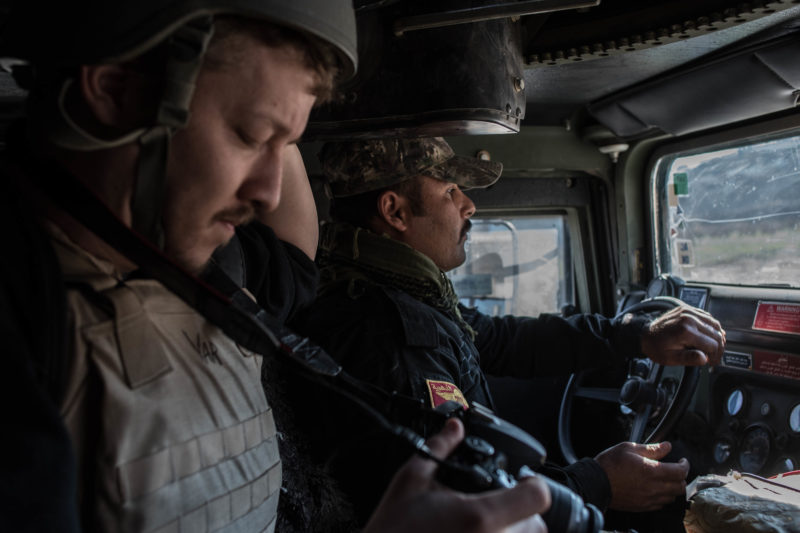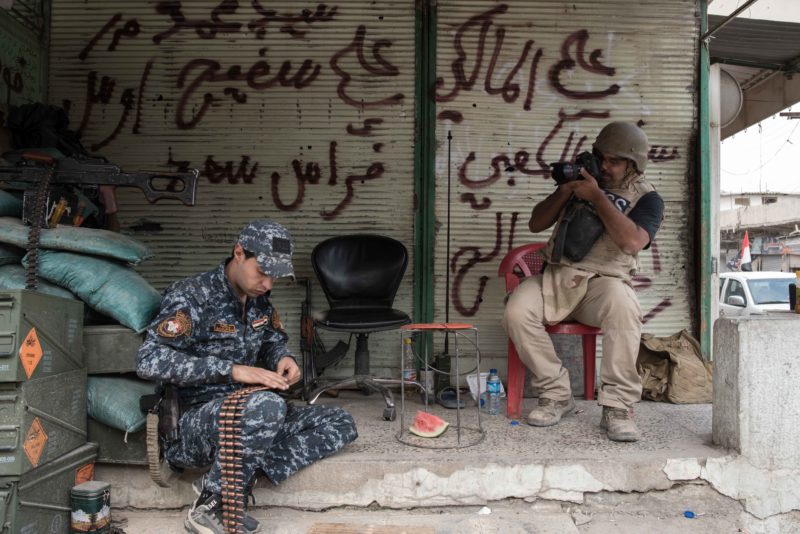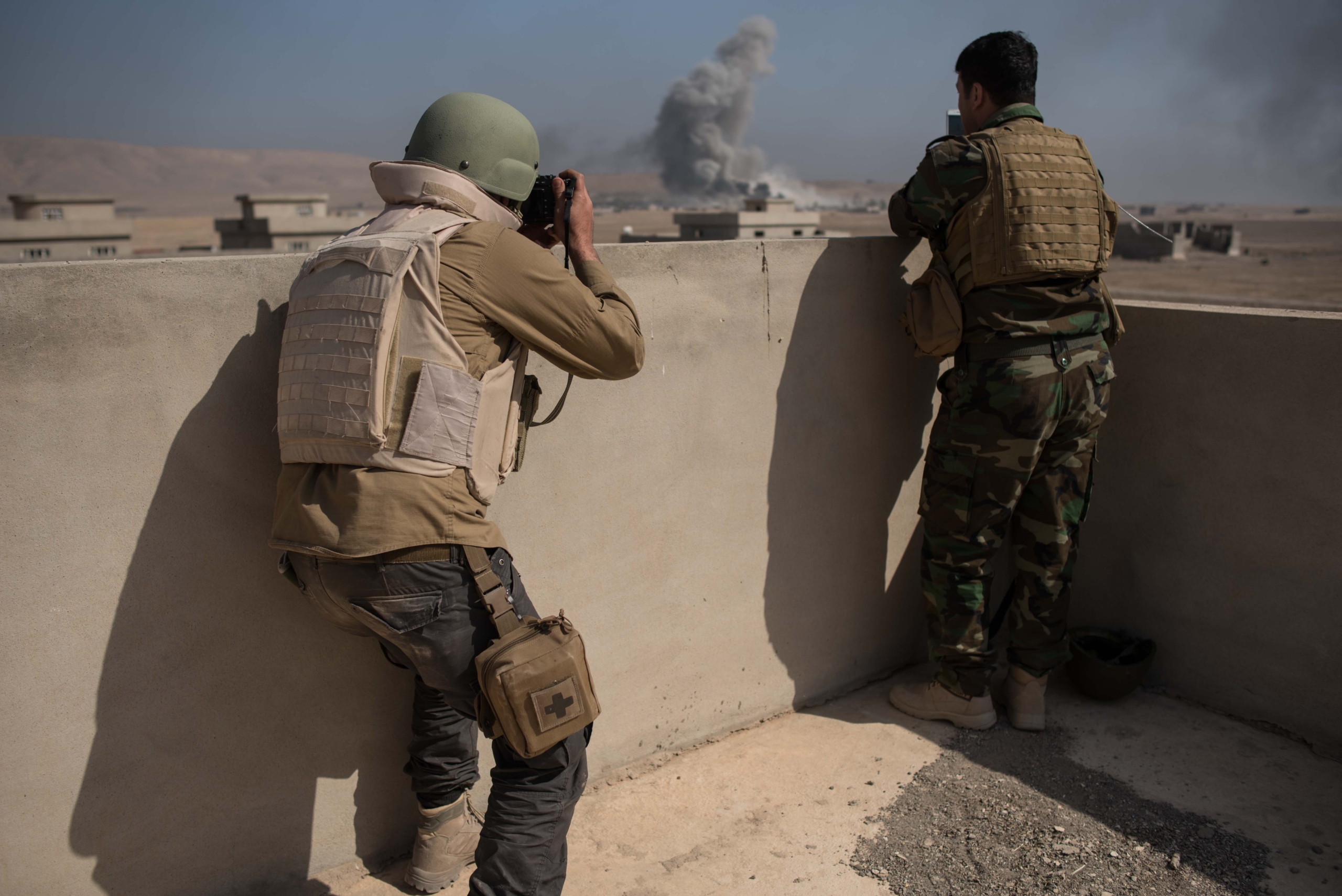ERBIL, Iraqi Kurdistan—The November day dawned much like any other in the battle to retake Mosul: clear and cold, with a high probability of suicide bombers. It had been five weeks since the start of the operation, and Iraqi Security Forces were still battling Islamic State militants on the eastern outskirts of the city.
I was driving into a newly liberated eastern neighborhood with two other freelance journalists and our fixer when I got a phone call. Another freelancer had just been injured by an Islamic State suicide truck bomb, which had brought a house down on top of him.
A moment later, the pressure changed inside our armored car and a dirty gray cloud rose high in the air a kilometer down the road. The sound of the explosion reached us a moment later. Another car bomb had detonated. During a short roadside discussion, we reasoned that if we returned without our stories, we would still have to pay our fixer. We pulled on flak jackets and helmets and resolved to continue with caution.
Shortly afterward, injured 27-year-old freelance filmmaker Joshua Baker was driven out of Mosul along the same road. By the time he reached the hospital in Erbil, where an X-ray showed he had a fractured spine, journalists he’d never met were waiting for him. “The first ones at the hospital were freelancers,” Baker said over Skype in January from his home in London, where he was recovering. “These people were not part of my production, but members of the freelance community who recognized the need to support each other.”
The battle for Mosul is the biggest urban battle since World War II, accessible to freelancers but also exceedingly dangerous. But while recent conflicts in the Middle East have highlighted the vulnerability of freelancers, Mosul is illustrating a new trend: The freelance community today is better prepared to face risk than at any point in the past. More aware now of the limits of what our industry will do for us, freelancers have realized the onus is on us to protect our own. At the same time, we are well aware that there is only so much we can do to take care of each other.
***
On a rooftop in a residential neighborhood of Erbil in late November, a group of 15 freelance journalists and local fixers grappled to apply tourniquets to mannequins slick with fake blood under the watchful eye of a former Danish special forces medic. The exercise, which occurred about a week before Baker was hurt, was part of a two-day medical and security training organized in haste after the Mosul operation began. “We just saw a huge need,” says Danish freelance multimedia journalist Anne Alling, co-founder of the Warzone Freelance Project. The project started as a way to highlight members’ work through multimedia exhibitions across Europe, but members covering the Mosul offensive saw a need for greater safety training among some of their colleagues. “The idea is to hold the training in the conflict areas and to tailor the content to that specific conflict,” says Alling.
The UK-based Rory Peck Trust was one of several organizations that provided financial support to two of these trainings in Erbil. Since 1995, the trust has offered practical assistance and support to freelance news-gatherers and their families worldwide, but has only recently started supporting group security and medical trainings around the world. “The initiative to organize this kind of thing has come from the freelance community,” says Catalina Cortes, the trust’s program officer for training bursaries.
The trust also offers grants for individual freelancers to undertake hostile environment training. Cortes says applications for these have increased markedly in recent years, from 49 in 2009 to 65 last year. (The trust gave me a grant to complete a four-day hostile environment training course in England in 2015.)
Increased interest in security training for freelancers has coincided with a tough period for freelancers, particularly in the Middle East. The popular uprisings that swept much of the Middle East and North Africa starting in late 2010 initially offered an unusually ripe environment for young freelancers to earn their credentials as conflict journalists. Plummeting advertising revenue during the previous decade had resulted in cost cutting, foreign bureau closures, and layoffs of experienced staffers. Freelancers—willing to work for less, without the safety net of insurance and support traditionally afforded by legacy publications—were eager to fill the gap.
The blossoming of peaceful protests was initially labelled the Arab Spring, but soon metastasized into dark conflicts in Syria and Libya that proved deadly training grounds for journalists. The deaths of photographers Tim Hetherington and Chris Hondros in Libya in April 2011 prompted a reevaluation of the way freelancers were reporting conflict. “Libya was a turning point,” says photojournalist Ivor Prickett, who has worked across the Middle East since 2009. “After Tim and Chris got killed and a whole lot of others got hurt, it became so much less acceptable for young people to be running around without a flak jacket and insurance.”

American freelance journalist Igor Kossov rides with an Iraqi special forces soldier in an armored vehicle in Mosul on January 17, 2017. Photo by Campbell MacDiarmid.
Following the two photojournalists’ deaths, their friend and colleague Sebastian Junger set up Reporters Instructed in Saving Colleagues (RISC), which offers free medical training training to freelancers. Following a four-day course involving battlefield simulations, every participant receives a medical pack to wear in the field. RISC has since trained 288 freelancers (I received RISC training in 2016).
Since the 1990s, hostile environment training has gradually become an industry standard for staff correspondents, but it is only now becoming a prerequisite for freelancers working in conflict zones. “When I began reporting in the late 1970s, no one talked about risk assessments or safety equipment or contingency planning,” veteran correspondent Judith Matloff wrote in an email. “An editor handed a staffer a bottle of Scotch and said, ‘Good luck.’”
Since then concern for the safety (and to a lesser extent, mental well-being) of staffers has become somewhat institutionalized, but progress for freelancers has until recently lagged behind. Matloff now runs safety workshops for journalists through the Columbia Journalism School and says that 62 people applied for 17 available places on the most recent course. “[That] shows that folks, or at least these folks, are taking security more seriously.”
Much of the impetus for freelancers to take a more formal approach to safety and security stems from editors’ growing reluctance to accept content from freelancers working in conflict zones unless they can demonstrate a professional approach to mitigating risk.
Much of the impetus for freelancers to take a more formal approach to safety and security stems from editors’ growing reluctance to accept content from freelancers working in conflict zones unless they can demonstrate a professional approach to mitigating risk. “I think Syria was the watershed,” says AP reporter Balint Szlanko. “It was so dangerous,”
Szlanko is currently coordinating the AP’s coverage of the Mosul offensive. But in 2013, when he was a freelancer, Szlanko was kidnapped in Aleppo. At the time, many inexperienced freelancers were filing from Syria for major publications and the wires, he says. “It doesn’t work like that anymore.”
Szlanko was eventually released, unlike his colleagues James Foley and Steven Sotloff.
I didn’t know Foley or Sotloff personally, but I vividly recall warm tears running down my face in an airport bar as I watched Foley kneel in the sand in an orange jumpsuit. It was August 2014, and I was moving from Cairo, where I had spent two years as an editor and reporter for local Egyptian English language publications, to northern Iraq, where I planned to freelance. Seeing the execution videos shook from me the last naive laxity toward my own safety.
In Iraq, I found that while many major publications were reluctant to commission freelance material from conflict zones, some were more relaxed. Some provided insurance; others asked for risk assessments ahead of assignments. Still others signed off with the same “Good luck” Matloff had received with that bottle of Scotch in the 1970s.
Since 2013, though, a collective of freelancers had been pushing for better treatment from clients. The Frontline Freelance Register is a representative body that advocates for its members well-being, while promoting a code of conduct encouraging freelancers to take responsibility for their safety. It now has four sets of body armor to loan to members—including one in Erbil. Members have organized briefings on topics such as IED awareness training and mental trauma, and the group’s Erbil representative has coordinated hospital visits for wounded freelancers. Thanks in part to their efforts, by the time the Mosul operation launched, it was unthinkable for most in the community to turn up at a frontline without flak jackets, helmets, and medical kits for both journalist and fixer.
As in any other war, though, plenty of inexperienced journalists have been drawn to the conflict here in Mosul. One returned from his first trip to a frontline to post the accomplishment of a “life goal” on Facebook: “Became a war reporter.” Another inexperienced freelancer wasn’t wearing body armor when he entered an Islamic State-held village at the vanguard of a Peshmerga column and was seriously injured in an explosion. Many had difficulty publishing enough work to sustain themselves. For one thing, most major outlets had correspondents on the ground, and with so many journalists in town, the costs of hiring a fixer skyrocketed.
Within the first few days of the operation, the Committee to Protect Journalists counted over a dozen journalists injured; local television reporter Shifa Gardi and and cameraman Ali Resan were killed covering the offensive.

Brazillian freelance journalist Yan Boechat photographs an Iraqi federal policeman in west Mosul on May 6, 2017. Photo by Campbell MacDiarmid.
Adding to the inherent danger of urban warfare was a willingness by Iraqi and Kurdish forces to let journalists embed in frontline units. “The Iraqis are very good hosts and they’re trying to accommodate journalists, but the safety aspect is often less prominent in their minds,” says the CPJ’s journalist safety specialist Colin Pereira. “They’re taking higher risks than Western armies and sustaining higher casualties… there’s almost an expectation that the journalists will do the same.”
Filmmaker Baker had thought he was in a safe area when he bedded down for the night with an Iraqi army unit on a residential street filled with families a mile back from the frontline. The next morning he and his crew awoke to cries of “moufakhakhah”—bomb. Shortly afterward, he found himself dazed and buried in rubble. Stumbling around, pulling wounded soldiers from a collapsed house, and administering first aid, it was 45 minutes before he realized how badly inured he was. Fortunately, his security planning involved having an evacuation vehicle waiting nearby, so he could be driven to the hospital without waiting for an ambulance.
After treatment in Erbil, Baker flew home to the UK to recover. Both in the field and at home, he found the support of the freelancer community overwhelming. In particular, he relied on the Rory Peck Trust to provide access to a mental health professional to talk through his experience after his employer’s insurance company declined to cover it. Freelancers are especially susceptible to post-traumatic stress disorder and other mental health issues, according to research by psychiatrist Anthony Feinstein, author of Journalists Under Fire: The Psychological Hazards of Covering War. “Symptoms are higher in freelance journalists than other journalists,” Feinstein says, partly because “health care provided to freelancers is not as good.”
“The [freelance] community is much more organized and prepared to look after each other now, and that is a byproduct of too many of our employers not looking after us,” Baker says. “The big news organizations, when something goes wrong, it’s often the first time they’ve dealt with something like that. It was the freelance community that truly looked after me in Iraq and back here.”
But Baker’s experience also highlights the limits of what freelancers are able to do for themselves, and the need for higher industry standards for the treatment of freelancers. “What the employers have got a lot better at is covering themselves from a legal standpoint,” Baker says, noting that concern for freelancer safety is often more about financial liability for an organization. “In some circumstances, they are telling you between the lines to take that risk, and that is incredibly dangerous and leaves freelancer vulnerable, because when it goes wrong, it’s on the freelancer.”
“Part of that is exactly right,” acknowledges Sharbil Nammour, who is the global director for security and risk at Vice. Eight months ago, Nammour began working in the newly-created role at Vice, which has been criticized for its treatment of freelancers. “We’re making sure that we have a clear editorial prerogative on safety versus the story that’s at the risk assessment stage,” he says, adding that Vice has initiated training sessions with editors to make that happen.
Vice is working hard in other areas to improve its relationship with freelancers, Nammour says. “We’re broadening the duty of care to include absolutely everyone who is on our team.” According to Nammour, that duty of care will afford freelancers and local staff the same security, legal, and insurance protections as staffers. “If we slap $200 on the hood of your beat up Mercedes and ask you to drive for us then you’re part of the team and we’re going to treat you as such.”
Vice is also one of more than 90 major news companies and organizations to partner with freelancers in a recent initiative that aims to resolve issues that can’t be solved by individual freelancers or publications alone. A Culture of Safety Alliance, known as ACOS, is pressing employers to adopt standards that would increase security for their freelance reporters. “What we want to do in promoting that culture of safety is make sure we all take a share of responsibility,” says ACOS executive director Elisabet Cantenys.
One major initiative is to create a medical insurance pool for freelancers, a massive challenge for underwriters, Cantenys says, given the variable numbers of freelancers to be covered by a plan. Cantenys says she’s confident the group will be be able to offer an affordable plan to freelancers soon, but the goal is ambitious and results have been slow to materialize.
Another goal of ACOS is to extend safety training to editors, to ensure they are aware of the dangers freelancers face. “We need to reach out to editors and news organizations to make sure they also take their responsibilities seriously,” she says.
Organizations within ACOS have begun responding to this call. According to Cantenys, BuzzFeed has made three places available at its in-house safety training in London for freelancers, and AP is now offering six spots on its upcoming hostile environment training course in Istanbul.
The freelancers who I interviewed for this article agreed that while any progress is positive, equitable treatment with staffers is still a long way off. Most of us are now living up to our responsibilities as professional journalists. It’s time for the rest of the industry to reciprocate.
Campbell MacDiarmid is a freelance journalist based in northern Iraq. You can follow him on Twitter and Instagram.

